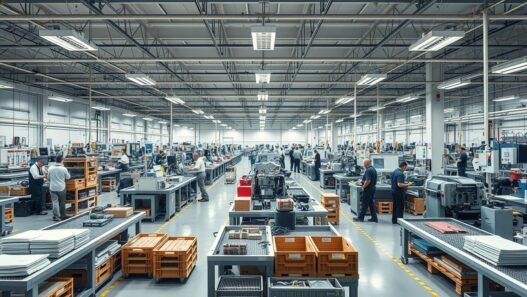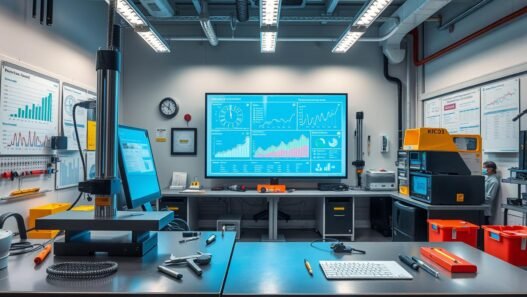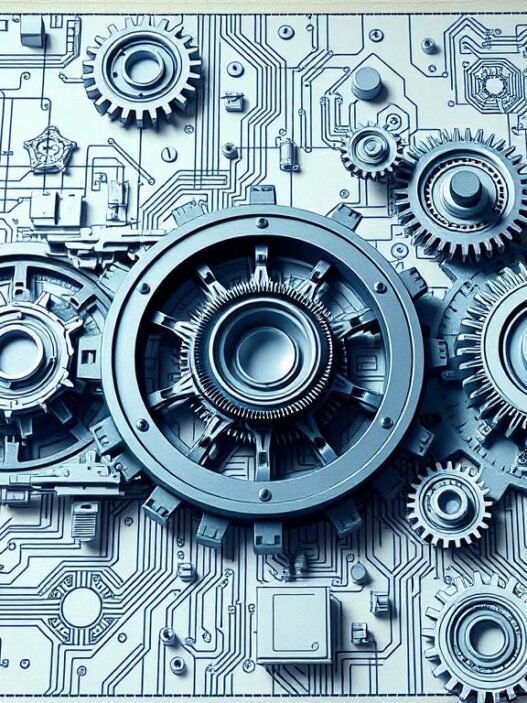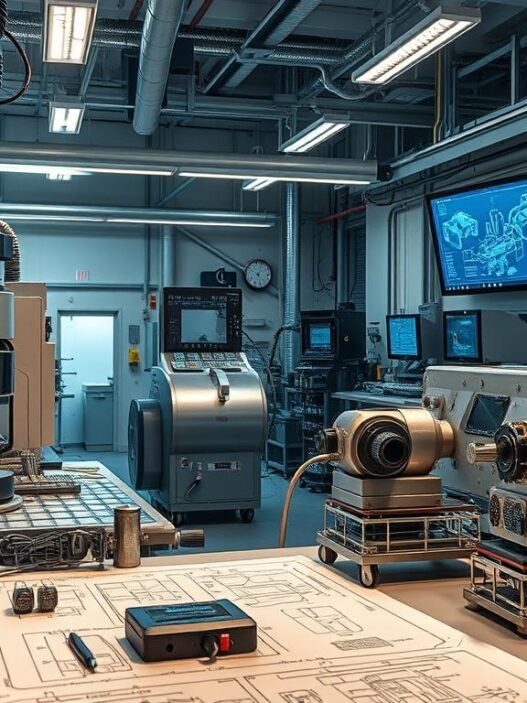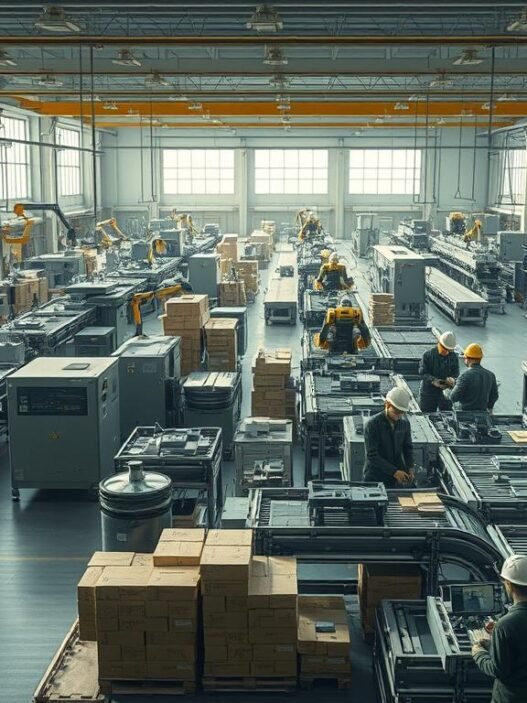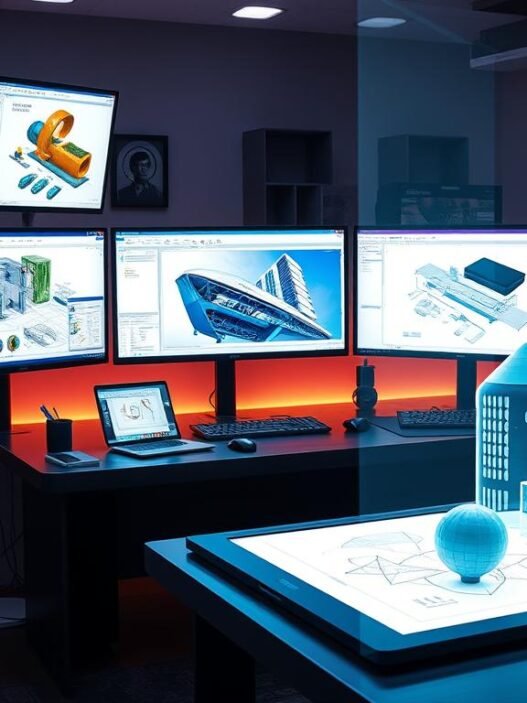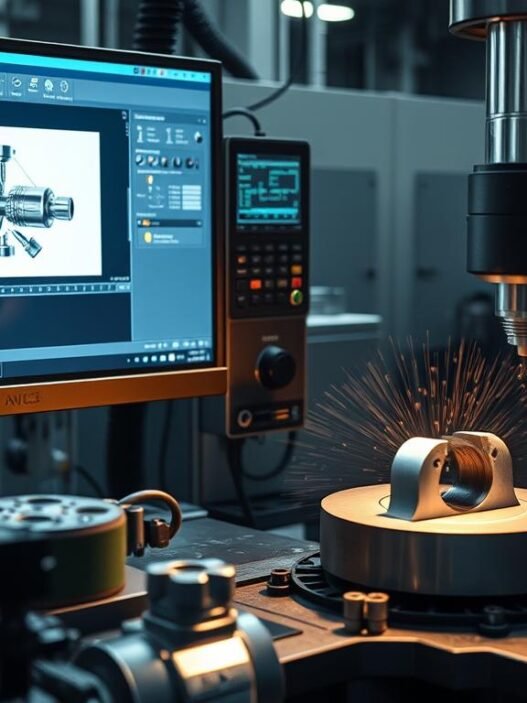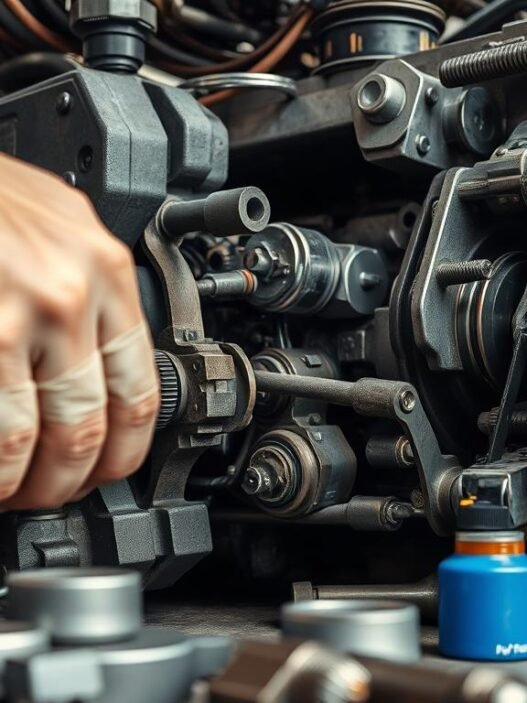Did you know the global industrial robotics market was valued at $13.6 billion in 2020? It’s expected to soar to $24.4 billion by 2027. This growth represents a compound annual growth rate (CAGR) of 9.6%. It shows the huge impact of robotics across various sectors. With artificial intelligence evolving, we see robots changing the face of industrial automation, healthcare, and the military.
Robotics blends engineering, computer science, and math. This mix creates machines that can do many tasks. For example, medical robots aided about 5.2 million surgeries globally in 2020. The service robotics market is also growing fast. It’s expected to increase at a 17% CAGR until 2027. This shows how robotics touches our everyday lives in big ways.
We’re going to look at different robots, how they work, and the role of AI in improving them. We’ll discuss the challenges, ethical issues, and what the future holds. This article shows that robotics is changing our world today. It’s not just about the future but making our lives better right now.
Key Takeaways
- The industrial robotics market is projected to grow from $13.6 billion in 2020 to $24.4 billion by 2027.
- 5.2 million robot-assisted surgeries were performed globally in 2020.
- The service robotics market is expected to see a 17% growth from 2020 to 2027.
- Military robotics spending is forecasted to reach $41.9 billion by 2027.
- Artificial intelligence integration in robots is anticipated to reach $12.36 billion in value by 2023.
What is Robotics?
Robotics combines different branches of engineering and technology. It’s crucial to understand it to see its wide effects. The robotics definition includes the idea of creating, building, operating, and using robots. These programmable machines can do tasks on their own, often like humans. Robotics involves mechanical and electrical engineering, computer science, and artificial intelligence. It shows how multidisciplinary engineering works.
Definition and Overview
The word “robotics” comes from “robot,” first used in a 1920 play by Karel Čapek. Isaac Asimov later made the robotics field known, along with rules for robot behavior. The first programmable robot, called Unimate, appeared in 1961. It was a major step for automation. Now, robots help in many industries. Companies like Amazon and Best Buy use them for various tasks. This increases work quality and efficiency.
Multidisciplinary Nature of Robotics
Robotics brings together many areas to create complex systems. These systems can do challenging jobs. There are robots for home security, AI improvements, and bioengineering advances. Robotics also touches on spaceships and tiny nanotechnology. Robots learn from doing, especially with machine learning. This fits well in its varied field. As robots grow and change, they’re used more in farming, healthcare, and the military. This shows ongoing creativity and progress.
| Discipline | Contribution to Robotics |
|---|---|
| Mechanical Engineering | Designing the structure and movement of robots. |
| Electrical Engineering | Developing circuits and power systems for functionality. |
| Computer Science | Coding algorithms for robot behavior and decision-making. |
| Artificial Intelligence | Enabling learning, adaptation, and intelligent responses. |
Evolution of Robotics
The story of robotics is a captivating journey from basic devices to advanced machines. These machines have revolutionized several industries. The history of robotics goes back centuries. Breakthroughs over these years have greatly influenced today’s robotics landscape.
Historical Background
The word “robot” originates from the Czech term “robota,” which means forced labor. It appeared first in the 1921 play “RUR (Rossum’s Universal Robots).” The 1950s saw the creation of the first mobile robot, ELSIE, in England. Robots then progressed rapidly, with significant developments in each decade. For example, the 1960s brought us SHAKEY, the first robot with tactile sensors and vision. The 1970s saw NASA develop MARS-ROVER. It had many sensors and a mechanical arm, leading to more complex robots.
Key Milestones in Robotics Development
In 1980, the invention of Unimate, the first industrial robot, marked a pivotal moment. This hydraulic arm started a boom in industrial robotics in Europe and Asia during the 1980s and 1990s. Robots became easier to control and program thanks to Programmable Logic Controllers (PLCs). In 2019, the introduction of adaptive robots brought artificial intelligence and machine learning into the picture. This advanced their performance in unpredictable environments significantly. These developments show how technology continues to push robotics forward.
Types of Robots
Robots do many tasks in different fields. They can be categorized based on the jobs they do. Learning about robots helps us understand their role in industries like manufacturing and healthcare.
Industrial Robots
Industrial robots are crucial in making things. There are about 3.5 million such robots worldwide. They do jobs like welding, painting, and putting things together. They make work faster and more accurate in car and electronics factories.
Service Robots
Service robots help with everyday activities. They include robots that clean homes, like Roomba, and those that teach kids coding. By doing simple tasks, these robots let us focus on more important things.
Medical Robots
Robots in medicine are changing how we care for people. The Da Vinci system, for example, helps surgeons be more precise. These robots are used in surgeries, helping patients, and in rehab. They aim to cut down on mistakes and boost patient care.
Military Robots
Military robots are used for spying and carrying goods. They have advanced sensors and talk to each other. These robots can gather information and hit targets accurately. This keeps soldiers away from danger.
Humanoid Robots
Robots like ASIMO look and move like humans. They are used in research and services, interacting with people naturally. This is a big step in robotics, showing how they might be used in healthcare and customer service.
For more on how robots change business, visit this resource. It talks about the impact of robotics and AI, looking at future trends and effects on society.
Key Components of a Robot
Robots have several key parts that make them work well. Knowing these parts helps us understand how robots work in different places. These include sensors, actuators, control systems, and a power supply. Each has an essential role in how robots function.
Sensors and Their Functions
Sensors help robots sense what’s around them. They use different sensors for different tasks:
- Cameras capture images of the surroundings.
- Microphones pick up sounds, which helps with moving and reacting.
- LIDAR sensors use lasers to map out areas in 3D for safe moving.
- Ultrasonic sensors measure distances, like echolocation.
Actuators: The Robot’s Muscles
Actuators are like a robot’s muscles. They allow robots to move and interact. Here are a few common types:
- Motors move parts and wheels.
- Servos adjust angles and positions accurately.
- Pneumatic actuators use air pressure for movement.
Control Systems: The Brain of the Robot
Control systems process information and send orders. They are like the robot’s brain. There are two main types:
- Top-Down architecture starts with the brain and connects other parts via AI programs.
- Bottom-Up architecture links sensors to actions directly, organizing behaviors by importance.
Power Supply Necessities
A reliable power supply keeps a robot going. The most common sources are:
- Batteries power many robots, making them mobile.
- Fuel cells are used in drones and driverless cars for efficient power.

The Role of Artificial Intelligence in Robotics
Artificial intelligence is reshaping robotics, making machines smarter and more capable. Robots, with machine learning, can learn from past actions, adjust to new situations, and work on their own with less help from humans.
Machine Learning and Adaptability
Machine learning is central to AI growth in robotics. It lets robots process a lot of data to spot patterns and decide what to do. Key areas it’s used in include:
- Jobs in fields like aerospace, needing quick adjustments and learning the best paths.
- Seeing and recognizing things with computer vision, helpful in health, entertainment, and the military.
- Automating customer service, where AI chatbots answer everyday questions, showing how well machine learning and robotics work together.
Future AI Innovations in Robotics
The future of AI in robotics looks exciting. For example, natural language processing will improve how we talk to machines. Other up-and-coming areas in AI are:
- Affective computing: Giving robots the ability to understand and react to human feelings.
- Edge computing: Better handling of data and security, making robots more reliable.
- Transfer learning: Helping robots use what they’ve learned before in new tasks, making work in various fields more efficient.
With ongoing AI progress, the scope for robotics is widening, leading to better teamwork between people and robots. The World Economic Forum suggests AI and robotics could generate 12 million jobs by 2025 in various sectors. This shows how vital AI is for the future of work.
| Statistic | Data |
|---|---|
| Job Creation by 2025 | 12 million new jobs |
| Average Salary of Robotics Engineers | $100,205 per year |
| Applications of AI-powered Chatbots | Customer service handling simple tasks |
| AI in Robotic Assembly | Real-time course correction in complex tasks |
Robotics in Different Industries
Robotics technology has grown a lot across different areas, changing how things work and making things better. In fields like healthcare, manufacturing, and exploration, robots are key. They bring better speed, safety, and new ideas.
Healthcare Applications
In healthcare, robots are changing surgeries, making them more precise. They help doctors be more accurate and patients recover quicker. Robots also help people walk again with special therapy programs. Image-guided surgeries are another big step, with over a million done so far.
Manufacturing and Automation
Manufacturing has really taken to robots, especially in making things. The car industry used 28% of all robots in 2020. Robots do welding and move materials, while others help cut fabric or load machines. Cobots work alongside people, making things safer and flexible. The electronics industry is also using more robots for putting things together and checking them, moving towards more automated workspaces.
Exploration in Space and Ocean
For exploring space, robots are now essential. They go to places we can’t, gathering data about other worlds. In the ocean, drones dive deep to learn about sea life and the ground beneath. These robots not only go further in exploration but also help a lot in scientific studies.

| Industry | Robot Applications | Benefits |
|---|---|---|
| Healthcare | Surgical robots, Rehabilitation robots | Increased precision, Faster recovery times |
| Manufacturing | Articulated arms, SCARA robots, Cobots | Improved efficiency, Enhanced flexibility |
| Exploration | Space rovers, Underwater drones | Data collection in extreme environments, Advancements in research |
Challenges and Ethical Considerations
Bringing robotics into different areas adds challenges and ethical questions. These issues need quick action. The effect of robotics on society gets more complicated as technology advances. It’s vital to understand these issues like job loss, privacy concerns, and responsible robotics use.
Job Displacement Concerns
Job loss is a major worry with more traditional roles being replaced by machines. Looking at employment changes over time shows this. For instance, in 1964, AT&T had about 758,611 workers. Today, Apple has around 137,000, even though it’s a top company.
This big drop shows how automation changes job markets. It shows we need to help workers learn new skills for new jobs. Companies should focus on training to help people adjust to these changes.
Privacy and Security Issues
As robotics become more involved in handling data and watching over things, privacy and security get more attention. When robots are used in services, keeping user data safe is a big deal. Studies show that privacy worries really impact whether people want to use robots.
It’s important to make strict rules and clear data practices. This builds trust with people and keeps their information safe.
Ensuring Responsible Use of Robotics
We must make sure robots are used in ways that are ethical and prevent misuse. The way robots are built and what they can do bring up new challenges. The industry needs to make sure people feel safe around robots. They need to trust them.
Things like social signals that make human-robot meetings better can make people more willing to use robots. Keeping a good balance between being innovative and following ethical rules is key for the future of robotics.
Future Prospects of Robotics
The future of robotics looks very bright, with major advancements in different areas. As new technologies come into play, robots are getting better at doing new things. They aim to work better with humans, making teamwork smoother in many fields.
Emerging Technologies in Robotics
New developments like soft robotics and swarm robotics are changing the game. Soft robotics brings flexibility, perfect for sensitive tasks in healthcare and making things. Meanwhile, swarm robotics, inspired by nature, uses teamwork to get jobs done more effectively. These new techs not only offer more ways to work but also boost productivity across industries.
Human-Robot Collaboration
Humans and robots working together is becoming more common. Soon, working with a robot will feel as natural as working with a colleague. Robots called cobots are good at doing the boring, repetitive tasks. This lets humans tackle the harder, more interesting work. This partnership opens new doors, especially where there are not enough workers, like in building stuff and making things.
Potential Bugs and Limitations
But, with all these advances, there are still hurdles to jump. Challenges like making sure the software works right, stopping hackers, and testing thoroughly highlight the need for safe and reliable robots. As robots become a regular part of life, overcoming these obstacles is key to gaining trust in what they can do. For those who want to dive deeper into robotics’ future, check out more here.
The Impact of Robotics on Society
The rise of robotics across different areas is changing our society. This technology is making things better by improving work and life worldwide. Robotics make businesses more efficient and can cut costs. This helps increase productivity.
Improving Productivity and Efficiency
Robots are changing the game in manufacturing, logistics, and farming. They have helped GDP growth in many countries by 0.36% annually. In farming, technologies like GNSS, SatEO, and Satcom help feed more people. This is leading to a big change in agriculture.
- Automation means workers can do more, which can bring down prices.
- Robots are great at doing the same task over without mistakes.
- Even as some jobs disappear, robotics open up new opportunities for skilled work.
Enhancing Quality of Life
Robotics is also stepping into healthcare and daily life. Innovations in soft robotics offer help with tasks that are tough for us. Using robots in social and medical care could change service delivery. This is especially true for older people and those with disabilities.
- Robots help deliver better healthcare and more independence for the disabled.
- Self-driving cars and drones could make transport more convenient and efficient.
- Medical robots improve surgeries, which means better results for patients.
Conclusion
The world of robotics is always changing, moving from ideas to real tools we use every day. In many fields like making goods, moving them, health care, and learning, robots have made work faster and better. They do tasks that need to be exact, quick, and safe, making things better for everyone.
Yet, the future of robotics has its challenges. Robots help by doing jobs that are boring or unsafe, but they can also take over jobs. We must make sure people are ready for new kinds of work in robotics. It’s important to find the right balance. We should use new tech wisely and protect jobs at the same time.
Looking forward, robots will do even more, with new tech helping them work better with people. This will change how industries work, letting people do the creative and thinking jobs. By using tech in the right way, we can make the most of robotics. This will lead to better workplaces and communities for us all.

